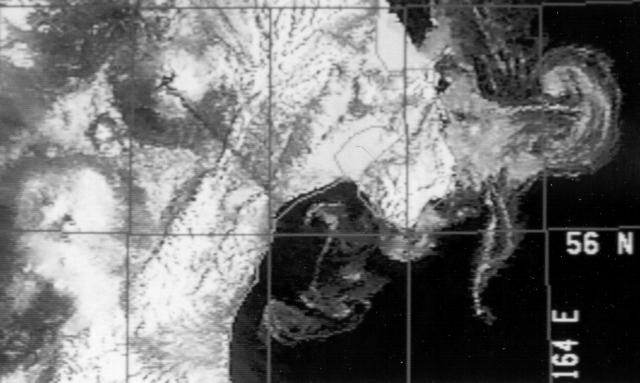Report on Sheveluch (Russia) — March 1991
Bulletin of the Global Volcanism Network, vol. 16, no. 3 (March 1991)
Managing Editor: Lindsay McClelland.
Sheveluch (Russia) 6-8-km-high column; tephra fall to coast
Please cite this report as:
Global Volcanism Program, 1991. Report on Sheveluch (Russia) (McClelland, L., ed.). Bulletin of the Global Volcanism Network, 16:3. Smithsonian Institution. https://doi.org/10.5479/si.GVP.BGVN199103-300270
Sheveluch
Russia
56.653°N, 161.36°E; summit elev. 3283 m
All times are local (unless otherwise noted)
At 1756 on 8 April, an explosive eruption began in the dome area, ejecting an ash cloud 6-8 km high that was visually tracked 40 km to the SE. The eruption, lasting 3-4 minutes, was the volcano's first known explosive activity of 1991. Satellite images at 0950 (NOAA 10) and 1430 (NOAA 11) on 9 April revealed a dark streak (~8-15 km wide, 110 km long, with an azimuth of ~135°) extending from the volcano to the coast (figure 2). Analysts suggested that the streak represented tephra deposited on snow. A thin plume, extending ~50 km SE from Shiveluch, was visible by satellite (NOAA 10) at 0942 on 14 April.
Geological Summary. The high, isolated massif of Sheveluch volcano (also spelled Shiveluch) rises above the lowlands NNE of the Kliuchevskaya volcano group. The 1,300 km3 andesitic volcano is one of Kamchatka's largest and most active volcanic structures, with at least 60 large eruptions during the Holocene. The summit of roughly 65,000-year-old Stary Shiveluch is truncated by a broad 9-km-wide late-Pleistocene caldera breached to the south. Many lava domes occur on its outer flanks. The Molodoy Shiveluch lava dome complex was constructed during the Holocene within the large open caldera; Holocene lava dome extrusion also took place on the flanks of Stary Shiveluch. Widespread tephra layers from these eruptions have provided valuable time markers for dating volcanic events in Kamchatka. Frequent collapses of dome complexes, most recently in 1964, have produced debris avalanches whose deposits cover much of the floor of the breached caldera.
Information Contacts: E. Gordeev, IV; T. Miller, AVO; G. Stephens and O. Karst, NOAA/NESDIS.


